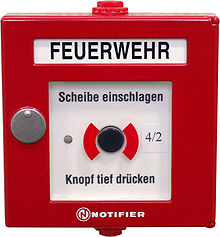Closed-circuit principle
The quiescent current principle describes the mode of operation of electrically operated systems or system parts, in which a defined, usually relatively small current , the quiescent current , constantly flows in the rest position . An action is only initiated when the current flow is interrupted, or when it goes out of the tolerance range upwards or downwards.
The opposite of this form of operation is the open-circuit principle , in which current flows when a signal is active or an element is actuated. Signals for status reports of electrical devices and systems and electrically operated actuators (also alarms) often work according to this. The open-circuit principle is not permitted for safety-related circuits.
The closed-circuit principle can ensure that in the event of malfunctions, in particular on safety-relevant components, the system always tilts to the safe, or at least to the less dangerous side. The generalization of this principle in engineering is described under the term fail-safe . A historical example from mechanical engineering is the Westinghouse brake , which is activated when the air escapes from the brake line.
The term closed-circuit principle goes beyond the term wire break safety , because in addition to a wire break, the "failure of the auxiliary power" is generally taken into account.
Closed-circuit current principle in actuators
In the case of electrically operated brakes, for example, the brake remains released when voltage is applied, and the quiescent current flows. In the event of a power failure , wire breakage or targeted actuation, the functional effect occurs when the brake engages. The braking effect takes place here via preloaded springs, which z. B. be solved by an electromagnet.
Closed-circuit current principle in sensors
When designing an electrical circuit, it must be decided whether the switch contact of the encoder (e.g. limit switch or pressure sensor) should be designed as an opener (closed-circuit principle) or normally-open (open-circuit principle). A distinction must be made between good reports and bad reports for safety-related circuits. For example, a pressure switch can report: “Working pressure available” (then ok) or “Operating pressure exceeded” (then switch off quickly). The danger or bad message is signaled by opening the circuit, i.e. interrupting the quiescent current, or a targeted increase or decrease in the idle current. Under certain circumstances, one accepts that the otherwise perfectly functioning system will only be shut down if there is a defective encoder. If the open-circuit current principle were applied, a defective encoder could not be recognized immediately, a hazard message would not be sent, which could lead to fatal consequences in the event of an actual system fault, in the example "operating pressure exceeded".
Important areas of application
- Safety brakes : In the event of a power failure, the braking effect starts.
- Door locks
- Alarm systems : The quiescent current is very precisely defined. If the signal lines are cut or bridged, the current changes and an alarm occurs. This protects the system against sabotage .
- Railway signaling / securing train journeys : If there is no quiescent current in a signal line, a fault is reported or displayed.
- Fire alarm system : If the signal line of the fire alarm is interrupted, an alarm is triggered.
- Emergency stop signal lines: If the line is cut, the emergency stop procedure is initiated.
International terms
In the English-speaking world, this topic is dealt with under the terms failsafe , failure safe design or failsafe circuit .
Individual evidence
- ↑ Working current / closed current website SecuPedia, accessed on April 17, 2017.
